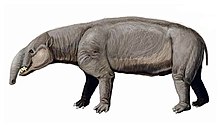Astrapotheriidae is an extinct family of herbivorous South American land mammals that lived from the Late Eocene (Mustersan SALMA) to the Middle Miocene (Laventan SALMA) 37.71 to 15.98 million years ago.[clarification needed] The most derived of the astrapotherians, they were also the largest and most specialized mammals in the Tertiary of South America. There are two sister taxa: Eoastrapostylopidae and Trigonostylopidae.
| Astrapotheriidae Temporal range:
| |
|---|---|

| |
| Life reconstruction of Astrapotherium magnum | |

| |
| Life reconstruction of Granastrapotherium snorki | |
| Scientific classification | |
| Domain: | Eukaryota |
| Kingdom: | Animalia |
| Phylum: | Chordata |
| Class: | Mammalia |
| Order: | †Astrapotheria |
| Family: | †Astrapotheriidae Ameghino 1887 |
| Genera | |
|
See text | |
Around 1900, Argentine paleontologist Florentino Ameghino described eight Colhuehuapian (Early Miocene) species from specimens he found south of Lake Colhué Huapi in Patagonia and grouped them into three genera: Parastrapotherium, Astrapotherium, and Astrapothericulus. It was obvious to Ameghino that these species represented a great diversity, ranging in size from a peccary to a rhinoceros, but his description was based entirely on fragmentary and not always comparable dental remains. Other expeditions to Patagonia have subsequently recovered considerably more complete materials.[1]
Genera
editAccording to Kramarz & Bond 2009, Astrapotheriidae includes two clades, Astrapotheriinae and Uruguaytheriinae, and a number of early genera (Astrapotheriidae incertae sedis): Astraponotus (Middle Eocene), Maddenia (Early Oligocene), and Parastrapotherium (Late Oligocene-Early Miocene). Most genera have been found in Patagonia and adjacent areas in Argentina and Chile; whereas members of Uruguaytheriinae have been found further north: Xenastrapotherium (Late Oligocene-Middle Miocene of northern South America), Granastrapotherium (Middle Miocene of Colombia), Uruguaytherium (uncertain age, from Uruguay).[2] According to Kramarz & Bond 2009, the genus Maddenia is a small, pre-Deseadan form of later astrapotheriids.[3] Simpson 1945 grouped Albertogaudrya together with Astraponotus in the subfamily Albertogaudryinae, synonymous with Albertogaudryidae Ameghino 1901.[4] Bond et al. 2011 concluded that a comprehensive evaluation is required regarding astrapotherids.[5]
- Incertae sedis
- Subfamily Albertogaudryinae Simpson 1945
- Subfamily Astrapotheriinae
- Subfamily Uruguaytheriinae
Notes
edit- ^ Kramaz & Bond 2010, Introduction, p. 183
- ^ Goillota et al. 2011, Introduction
- ^ Kramarz & Bond 2009, Abstract
- ^ Simpson 1945, p. 130
- ^ Bond et al. 2011, Relationships
- ^ M. C. Vallejo-Pareja; J. D. Carrillo; J. W. Moreno-Bernal; M. Pardo-Jaramillo; D. F. Rodriguez-Gonzalez; J. Muñoz-Duran (2015). "Hilarcotherium castanedaii, gen. et sp. nov., a new Miocene astrapothere (Mammalia, Astrapotheriidae) from the Upper Magdalena Valley, Colombia" (PDF). Journal of Vertebrate Paleontology. 35 (2): e903960. Bibcode:2015JVPal..35E3960V. doi:10.1080/02724634.2014.903960. S2CID 130728894.
References
edit- Ameghino, Florentino (1887). Apuntes preliminares sobre algunos mamíferos estinguidos del yacimiento de "Monte Hermoso" existentes en el "Mueso La Plata". Buenos Aires. OCLC 39794328.
{{cite book}}: CS1 maint: location missing publisher (link) - Ameghino, Florentino (1891). "Los monos fósiles del Eoceno de la República Argentina" (PDF). Revista Argentina de Historia Natural. 1 (6). Buenos Aires: 383–397. Retrieved 9 March 2013.
- Ameghino, Florentino (1895). Première contribution à la connaissance de la faune mammalogique des couches à Pyrotherium. Buenos Aires: P.E. Coni.
- Ameghino, Florentino (1897). "Mamiferos Cretaceos de la Argentina. Segunda contribucion al conocimiento de la fauna mastologica de las capas con restos de Pyrotherium". Boletin Instituto Geografico Argentino. 18: 406–521.
- Ameghino, Florentino (1901). "Notices préliminaires sur des ongulés des terrains Crétacés de Patagonie". Boletín de la Academia de Ciencias en Córdoba. 16: 349–426. OCLC 123174974.
- Bond, Mariano; Kramarz, Alejandro; Macphee, Ross D. E.; Reguero, Marcelo (June 2011). "A New Astrapothere (Mammalia, Meridiungulata) from La Meseta Formation, Seymour (Marambio) Island, and a Reassessment of Previous Records of Antarctic Astrapotheres" (PDF). American Museum Novitates (3718): 1–16. doi:10.1206/3718.2. hdl:2246/6118. OCLC 728156717. S2CID 58908785. Retrieved 9 March 2013.
- Burmeister, Hermann (1879). Description physique de la République Argentine : d'après des observations personnelles et étrangères. Vol. 3 Animaux vertébrés, 1. partie, Mammifères vivants et éteints. Paris: Savy. p. 520. OCLC 162707154.
- Goillota, Cyrielle; Antoinea, Pierre-Olivier; Tejadab, Julia; Pujosc, François; Gismondid, Rodolfo Salas (2011). "Middle Miocene Uruguaytheriinae (Mammalia, Astrapotheria) from Peruvian Amazonia and a review of the astrapotheriid fossil record in northern South America" (PDF). Geodiversitas. 33 (2): 331–345. doi:10.5252/g2011n2a8. S2CID 129460591. Retrieved 9 March 2013.[permanent dead link]
- Johnson, Steven C.; Madden, Richard H. (1997). "Uruguaytheriine Astrapotheres of Tropical South America". In Kay, Richard F.; Madden, Richard H.; Cifelli, Richard L.; Flynn, John J. (eds.). Vertebrate paleontology in the neotropics : the Miocene fauna of La Venta, Colombia. Washington: Smithsonian Institution Press. pp. 355–82. ISBN 9781560984184. OCLC 30320084.
- Kraglievich, Lucas (1928). Sobre el supuesto Astrapotherium Christi Stehlin, descubierto en Venezuela (Xenastrapotherium n. gen.) y sus relaciones con Astrapotherium magnum y Uruguaytherium Beaulieui. Buenos Aires: La Editorial Franco-Argentina. OCLC 20881142.
- Kramarz, Alejandro G; Bond, Mariano (2009). "A new oligocene astrapothere (Mammalia , Meridiungulata) from Patagonia and a new appraisal of astrapothere phylogeny". Journal of Systematic Palaeontology. 7 (1): 117–128. doi:10.1017/S147720190800268X. hdl:11336/102700. S2CID 85351962.
- Kramarz, Alejandro; Bond, Mariano (2011). "A new early Miocene astrapotheriid (Mammalia, Astrapotheria) from Northern Patagonia, Argentina". Neues Jahrbuch für Geologie und Paläontologie, Abhandlungen. 260 (3): 277–87. doi:10.1127/0077-7749/2011/0132. hdl:11336/68995. OCLC 740850188.
- Kramaz, Alejandro G.; Bond, Mariano (2010). "Colhuehuapian Astrapotheriidae (Mammalia) from Gran Barranca south of Lake Colhue-Huapi". In Madden, Richard H.; Carlini, Alfredo A.; Vucetich, Maria Guiomar (eds.). The Paleontology of Gran Barranca: Evolution and Environmental Change Through the Middle Cenozoic of Patagonia. Cambridge University Press. ISBN 9780521872416. Retrieved 9 March 2013.
- Simpson, George Gaylord (1945). The principles of classification and a classification of mammals. Bulletin of the AMNH. Vol. 85. New York: American Museum of Natural History. hdl:2246/1104. OCLC 341579.
- Simpson, George Gaylord (1957). "A new Casamayoran astrapothere". Revista del Museo Municipal de Ciencias Naturales y Tradicional de Mar del Plata. 1 (3): 11–18. OCLC 81633287.
External links
edit- "Astrapotheriidae". GBIF Portal. Archived from the original on 2016-03-04. Retrieved 9 March 2013. Astrapotheriidae occurrences distribution map
- Astrapotheriidae in the Paleobiology Database. Retrieved 9 March 2013.